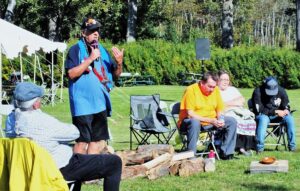Anishinabek Chiefs meet again at former Indian Residential School site in ceremony
Trigger warning: readers may be triggered by the recount of Indian Residential Schools. To access a 24-hour National Crisis Line, call: 1-866-925-4419. Community Assistance Program (CAP) can be accessed for citizens of the Anishinabek Nation: 1-800-663-1142.

By Leslie Knibbs
SPANISH— For the second time this year, Chiefs from Sagamok Anishnawbek First Nation and Serpent River First Nation, as well as now Acting Chief Gloria Daybutch from Mississauga #8 met on the grounds of the former Indian Residential School in Spanish on Sept. 18 in a ceremony called Nojomowinaan Ginishnaabewinanig (Healing Our People), reflecting on the discoveries of unmarked graves of children at many of these schools across Canada.
Since the first discovery of 215 graves at the former Kamloops Indian Residential School in B.C., the number of graves found across Canada has increased to over 1,300; moreover, the majority of these institutions have yet to be investigated including the grounds of the two schools in Spanish. The schools in Spanish were the largest in Canada. The Truth and Reconciliation Commission (TRC) estimates over 6,000 children are buried at Indian Residential Schools in Canada.
The Chiefs first met on Jun. 28 this year in Spanish to reflect on and discuss how they as leaders of their respective communities could explore the former site for unmarked graves as a united group. As the Chiefs did at the first meeting in June, the gathering on Sept. 18 brought them together again around the sacred fire to share storytelling and reflect on the lost children and the need to bring them home.
Elder Richard Assinewea, an Anishinaabe from Wiikwemkoong Unceded Territory, led the ceremonies throughout the day starting with a Sunrise Ceremony. The day-long gathering included sharing circles around the sacred fire, feasting, a Sweat Lodge, and storytelling from the Chiefs, as well as teachings from Elder Richard Assinewea.
“We are here around the sacred fire to listen,” said Anishinabek Nation Grand Council Chief Reg Niganobe, former Chief of Mississauga #8, at the first meeting in June. “We listen to the children here and our ancestors.”
And listen they did during a sweat at the September meeting. Councilor Brent Niganobe representing Mississauga #8 led a sweat with Chiefs Alan Ozawanimke of Sagamok Anishnawbek and Chief Brent Bissaillion of Serpent River taking part, listening to ancestors and the children from the school looking for direction.
The Saturday ceremony included a Sweat Lodge that was available for anyone wishing to attend. First Nation leadership all took part in a sweat. A mixed sweat was led by Elder Wayne Southwind at around 1 pm. A mid-day Feast was held at noon with each of the Chiefs doing food offerings on the children’s behalf. Elder Assinewea spoke of the importance of the food offering during a grieving ceremony.
Shortly after coming out of the Sweat Lodge, leadership gathered around the sacred fire sharing stories and teachings with community members present. Chief Ozawanimke shared a particularly moving story of his childhood telling those gathered of his witnessing of true reconciliation involving a personal experience with his father. Emotions rose to the surface for Chief Ozawanimke and many of those in attendance. There was laughter and a heartfelt sense of sadness for everyone listening; the poignancy of the story was not something abstract but rather tangible, cutting deep to the very heart of First Nation storytelling for everyone around the sacred fire.
In closing, Chief Alan Ozawanimke spoke of needing permission from the children before disturbing any of the graves. And that was most important on Saturday when looking for answers from the children.
According to Chief Ozawanimke, the First Nations will apply for funding from both the federal and provincial governments to conduct examinations of the resting places. Additionally, the First Nations’ intentions are to look at acquiring the properties the children’s graves are located on. In the case of the Spanish Indian Residential School sites, the property is now privately owned. The federal government has committed to allocating $321 million to First Nations to perform searches and provide assistance to Indian Residential School Survivors. The provincial government has allocated $10 million over three years for the same purpose.
At this time, the leadership from all three First Nations are contemplating their decision on how to approach the investigation of graves at the Spanish Indian Residential School sites. The leadership will release their intentions in the near future. According to a media relations officer in Sagamok, a decision will be made shortly, well in advance of September 30, the National Day of Reconciliation.
“We decided to take the slow and steady approach to ensure we are providing strong mental health, cultural supports, and doing this in the right way,” stated Chief Brent Bissaillion. “I’m incredibly proud to work alongside Sagamok and Mississaugi in building our relationships and working together on these very important issues that affect all our communities.”
In a subsequent meeting, all leadership met again in preparation for the next steps which include a joint news release.
“We have agreed that we will require support service and a strategic approach as we move forward,” stated Chief Ozawanimke. “e will keep in touch as communication is key.”
Following the ceremonies, an end-of-the-day supper was provided to all those attending.
It is important to remember September 30 is much more than a day off work. It is a day to remember and think long and hard about the atrocities committed by the church and government under the guise of being schools. The children are restless now, and, somehow in spirit are coming to life again speaking to the leadership of all First Nations including leadership from Sagamok, Mississauga, and Serpent River First Nation. Do remember the children deserve to be taken home to their families. Let them rest in peace. Do remember what it is all about.


